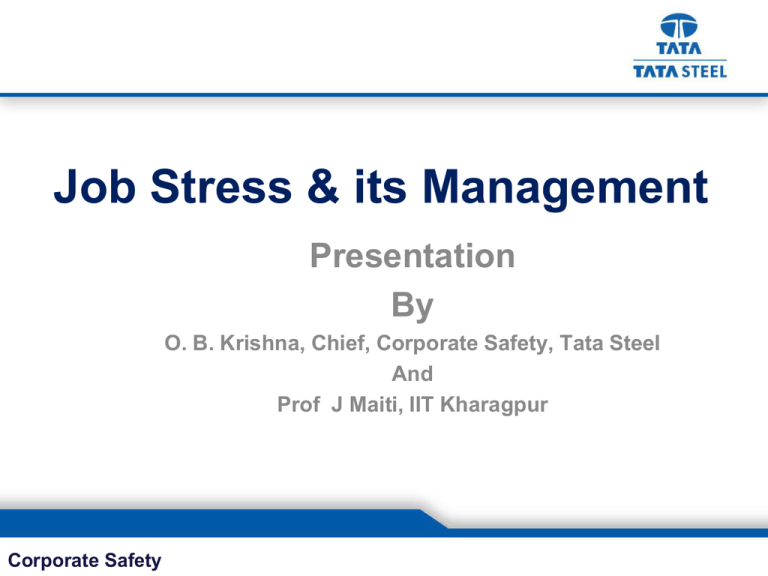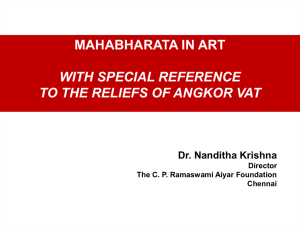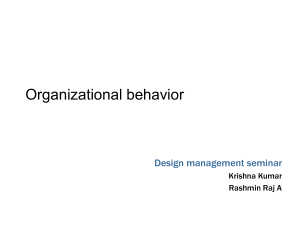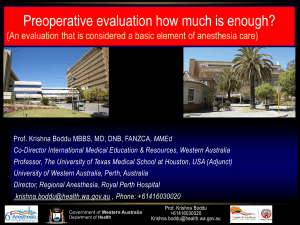Mr OB Krishna - Ciiersafety.com
advertisement

Job Stress & its Management Presentation By O. B. Krishna, Chief, Corporate Safety, Tata Steel And Prof J Maiti, IIT Kharagpur Corporate Safety Outline of Session • • • • • • • • Stress and Job stress – introduction Burden of Job stress Effects of Job stress Causes of Job stress Job Stress Model of Palmer Managing Job Stress – 5 step approach Interventions for job stress Tata Steel Experience Corporate Safety O.B.Krishna 2 Stress… • Living in today’s world has brought with it, not only innumerable means of comfort, but also a plethora of demands that tax human body and mind. • Now-a-days everyone talks about stress at work and at home. • Stress is an inevitable and unavoidable component of life due to increasing complexities and competitiveness in living standards. Corporate Safety O.B.Krishna 3 Job Stress • Occupational stress / Job stress is becoming the single greatest cause of occupational disease and can have adverse consequences for both the worker and the workplace. • Job Stress or work stress is defined as the response people may have when presented with work demands and pressures that are not matched with their knowledge and abilities and which challenge their ability to cope with the situations . Corporate Safety O.B.Krishna 4 Positive and Negative Stress • People get confused about the difference between pressure and stress. • We all experience pressure regularly – it can motivate us to perform at our best (Positive stress). • When we experience too much pressure and feel unable to cope up with it stress can result (Negative Stress) Corporate Safety O.B.Krishna 5 Burden of Job Stress • 45% American managers suffer too much stress at work (Smith, 1998). • According to the HSE, UK, in 2005 more than 500,000 people in the UK believed that, they were experiencing work-related stress at a level that was making them ill. • The total health and productivity cost of worker stress to American business is estimated at $50-$150 billion annually (Sauter ,1990). • As per HSE estimates the costs to society of work related stress to be around £4 billion each year, while 13.5 million working days were lost to stress in 2007/08. Corporate Safety O.B.Krishna 6 How Stress Affects • As per ILO, worldwide stress is recognized as major challenge to workers health and healthiness of the organization. • Workers who are stressed are more likely to be unhealthy, poorly motivated, less productive and less safe at work. Corporate Safety O.B.Krishna 7 Effect of Job Stress on Employee Workplace Stress and Health Effects Corporate Safety O.B.Krishna 8 Effect of Job Stress on Organization • • • • • Reduced productivity Absenteeism Illnesses Poor employee morale Increased employee turnover • Higher accidents and Injury rates • Higher medical expenses Corporate Safety O.B.Krishna Source: Reducing Stress at Workplace : - An Evidence Review 9 Causes of Job Stress • Demographic • Work Related • Age • Gender • Experience • Educational level • Personal • Personality • Coping ability • Work home interface Corporate Safety O.B.Krishna • Demand • Control • Support • Relationship • Role • Change 10 Work Related Causes of Job Stress • Demands: Includes factors intrinsic to the job such as workload, shift work, long or unsocial work hours and work conditions. • Control: How much autonomy a person has over his job; low levels of job control are typically linked to high levels of stress. • Relationships: Relationships with superiors, subordinates and colleagues can play a part in on individual’s stress levels, conflict, harassment and bullying in the workplace are all linked to heightened stress. Corporate Safety O.B.Krishna 11 Work Related Causes of Job Stress • Role: Stress may be triggered when an individual does not have a clear understanding of his role, when there is conflict between roles or ambiguity with regards to position and degree of responsibility. • Support: The amount of support and job training available, as well as encouragement, sponsorship and resources provided by colleagues and management. • Change: The way in which change is introduced, managed and communicated to staff can impact on levels of stress, as badly planned change results in excess pressure. Corporate Safety O.B.Krishna 12 Job Stress Model Corporate Safety O.B.Krishna 13 Why to Manage Job Stress ? • • • • • • Reduction of Sickness Reduction of Sickness Absenteeism Improved employee morale Employee Retention Improve Production Creating Healthy Workplaces Corporate Safety O.B.Krishna 14 Five Step Approach for Job Stress Management Corporate Safety O.B.Krishna 15 Five Step Approach for Job Stress Management • The Health & Safety Executive (HSE), UK guide (2001 & 2007) provided a five-step Work related stress risk assessment guide to aid the diagnosis of problems and provide a framework for intervention. • The five steps are described below. 1. 2. 3. 4. 5. Looking for hazard Who might be harmed and how Evaluate the risk Record you findings Monitor and Review Corporate Safety O.B.Krishna 16 Step-1 – Looking for hazard (Work Stress Assessment) • Identifying work related factors leading to stress • • • • • • Demand Control Support Relationship Role Change • In order to identify these factors - qualitative and quantitative data gathering methods could be used. Corporate Safety O.B.Krishna 17 Quantitative Methods • Productivity and performance data, • Absence/sickness data, • Employee Assistance Programmes (EAPs) data, • Staff turnover, • Stress questionnaires, • Stress audits. Corporate Safety O.B.Krishna 18 Qualitative Methods • • • • • Focus groups discussion, Performance appraisals, Informal discussions with staff, Return-to-work interviews, Exit interviews. Corporate Safety O.B.Krishna 19 Step-2 Who can be at Risk • Employees can suffer from stress regardless of age, status, gender, ethnicity or disability. • However, some employees may be at a higher risk than others, like, – Those working away from home, – Going through a difficult personal experience such as bereavement or relationship breakdown, or illness. Corporate Safety O.B.Krishna 20 Step -3, Evaluate the Risk • Risk assessment is important to consider how the stress factors like, Demand, Control, Support, Relationship, Role, Change could harm the department/unit/division and up to what extent. • What has already been done for them ? • What more can be done? Corporate Safety O.B.Krishna 21 Strep-4, Record the Findings • Keeping record of the Work related Stress findings helps in monitoring the progress of the particular hazard. • It can be a legal requirement also. • It is important to ensure confidentiality to avoid possible litigation. Corporate Safety O.B.Krishna 22 Step 5, Monitor and Review • The WRS risk assessment should be reviewed whenever significant changes occur within the organisation or department and monitored against the action plan. • The review should take place in full consultation with employees. • The risk assessment should be used as a continuous improvement model. Corporate Safety O.B.Krishna 23 Interventions for Job Stress • Interventions for job stress have multiplied rapidly over the last two decades, paralleling the increasing recognition and acceptance of the adverse impacts of job stress on individuals and organizations • Interventions to improve the organization of work and reduce the impact of stressful jobs on health can be conducted in a wide variety of ways. Corporate Safety O.B.Krishna 24 Intervention • Intervention can be made at the level of, • • • • Job Organization Individual Outside the organization through laws and regulations. • Interventions are of three types. – Primary – Secondary – Tertiary Corporate Safety O.B.Krishna 25 Primary Interventions • Primary prevention refers to efforts to protect the health of people who have not yet become sick. • These interventions are proactive, aiming to prevent exposures to stressors and the occurrence of illnesses among healthy individuals. • Targets are the sources of stress / stressors at workplace, through alterations in – Physical or – Psychosocial work environments, or – Through organizational changes. Corporate Safety O.B.Krishna 26 Examples of Primary Interventions • • • • • Improving organisational culture, Changing employee workloads, Job reengineering, Job redesign, Developing clear job descriptions to avoid role ambiguity, • Increasing worker involvement and participation in decision making, • Redesigning the physical work environment. Corporate Safety O.B.Krishna 27 Secondary Prevention • Secondary level interventions focus on altering the way that individuals respond to stressors at work (including perception) and to improve their of coping abilities. Includes, 1. Relaxation • Aims at reducing the arousal and tension associated with stress. 2. Cognitive Behavior Training (CBST) • CBST try to alter the interpretation of stressors, and offering support in dealing with it. Corporate Safety O.B.Krishna 28 Tertiary Prevention • Directed towards treating and assisting employees who are already been exposed to job stress and developed stress-related health outcomes like, Psychological injury, Depression, or Coronary heart disease. • These interventions include, – Occupational rehabilitation services, – Employee Assistance Programme (EAP) and Counselling and – Return to work programs. Corporate Safety O.B.Krishna 29 Combinations of Interventions Corporate Safety O.B.Krishna 30 Job stress management – TATA Steel Corporate Safety O.B.Krishna 31 Job Stress – TATA Steel Experience • Adoption of HSE – 5 step approach for stress management programme at TATA Steel. • Launching at Tarapore Wire Division, • Step 1. – Assessment for Job Stress • Quantitative Method for job stress assessment with a OSI tool was used . • OSI tool of Singh and Srivastava was used for Job stress assessment Corporate Safety O.B.Krishna 32 Stress Questionnaire • Also known as Occupational Stress Index / Stress measurement tools • Various International / National Questionnaires like, – NIOSH Generic Job Stress Questionnaire – Occupational Stress Index by Karen Belkic. – OSI by Singh and Srivastava – a widely used OSI tool in India. Corporate Safety O.B.Krishna 33 OSI tool – Singh and Srivastava • OSI tool used at TATA steel • This scale consists of 46 items, 28 are ‘True – Keyed’ and 18 are ‘False – Keyed’. • Each to be rated on the five point scale (1=Strongly Disagree to 5=Strongly Agree). • Items relate to almost all the components of the job which cause stress – as sub groups • There total 12 sub-groups. • Provides results as total stress scores and sub group stress scores Corporate Safety O.B.Krishna 34 OSI tool – Singh and Srivastava • Sub Groups: – – – – – – – – – – – – Corporate Safety Role over-load, Role ambiguity, Role conflict, Unreasonable group and political pressure, Responsibility for persons, Under participation, Powerlessness, Poor peer relations, Intrinsic, impoverishment, Low status, Strenuous working conditions and Unprofitability. O.B.Krishna 35 Launching at TWP Corporate Safety O.B.Krishna 36 Development Steps Data Collection with the help of OSI tool for employees Data Entry in Microsoft Excel Data Analysis with the help of Standard Statistical Tools - SPSS Risk Identification / Categorization Corporate Safety O.B.Krishna 37 Preliminary Results Corporate Safety O.B.Krishna 38 Future Actions….. • Analysis for Sub-Group stress levels and identifying job related hazards leading to overall stress (Risk Factors) • Interventions based on the risk factors – Primary – Secondary – Tertiary • Implementation at all other locations of TATA Steel. Corporate Safety O.B.Krishna 39 Healthy Workplaces @ TATA Steel OHS Industrial Hygiene Ergonomics Stress Management Programme Wellness @ Workplace Anemia Control Programme for Female employees Sunshine Vitamin Programme “JAGRAN” Programme Health Camps and Health promotion activities in communities. Corporate Safety O.B.Krishna 40 Thank You Corporate Safety O.B.Krishna 41










